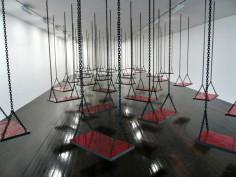MONA HATOUM
מונה חאטום
МОНА ХАТУМ
蒙娜丽莎哈透姆
منى حاطوم
Suspendu

source: whitecube
Mona Hatoum’s poetic and political oeuvre is realised in a diverse and often unconventional range of media, including installations, sculpture, video, photography and works on paper.
Hatoum started her career making visceral video and performance work in the 1980s that focused with great intensity on the body. Since the beginning of the 1990s, her work moved increasingly towards large-scale installations that aim to engage the viewer in conflicting emotions of desire and revulsion, fear and fascination. In her singular sculptures, Hatoum has transformed familiar, every-day, domestic objects such as chairs, cots and kitchen utensils into things foreign, threatening and dangerous. Even the human body is rendered strange in works such as ‘Corps étranger’ (1994) or ‘Deep Throat’ (1996), installations that use endoscopic journeys through the interior landscape of the artist’s own body. In Homebound (2000) and Sous Tension (1999) Hatoum uses an assemblage of household furniture wired up with an audibly active electric current – combine a sense of threat with a surrealist sense of humour to create works that draw the viewer in on both an emotive and intellectual level. In smaller sculptures such as Traffic (2004) and Twins (2006) Hatoum uses found materials, rich with patina and laden with personal resonance, to create poetic, beguiling works on an intimate scale.
Mona Hatoum was born into a Palestinian family in Beirut, Lebanon in 1952 and now lives and works in London and Berlin. She has participated in numerous important group exhibitions including The Turner Prize (1995), Venice Biennale (1995 and 2005), Documenta XI, Kassel, 2002 and Biennale of Sydney (2006). Solo exhibitions include Centre Pompidou, Paris (1994), Museum of Contemporary Art, Chicago (1997), The New Museum of Contemporary Art, New York (1998), Castello di Rivoli, Turin (1999), Tate Britain, London (2000), Hamburger Kunsthalle, Kunstmuseum Bonn, Magasin 3, Stockholm (2004) and Museum of Contemporary Art, Sydney (2005). Recent exhibitions include Measures of Entanglement, UCCA, Beijing (2009), Interior Landscape, Fondazione Querini Stampalia, Venice (2009), Witness, Beirut Art Center, Beirut (2010), Le Grand Monde, Fundaciòn Marcelino Botìn, Santander (2010). In 2011 Mona Hatoum was awarded the prestigious Joan Miró Prize.
.
.
.
.
.
.
.
source: histoire-immigrationfr
Elle est née à Beyrouth (Liban) en 1952. Elle vit et travaille entre Londres et Berlin.
Mona Hatoum naît à Beyrouth dans une famille palestinienne. En 1975, alors qu’elle est en visite à Londres, elle se voit dans l’impossibilité de rejoindre son Liban natal et ses proches : la guerre civile vient d’éclater. Dès lors, elle choisit de questionner son statut de femme et d’exilée à travers une œuvre poétique et exigeante où se mêlent menace de la guerre, expérience de l’exil, questionnement identitaire, dépaysement et arrachement. Au milieu des années 1980, l’artiste se fait connaître sur la scène internationale avec ses performances et ses vidéos qui laissent poindre la violence du monde contemporain.
.
.
.
.
.
.
.
source: art-magazinde
Mit Mona Hatoum läutete die Region Marseille “Capitale Européenne de la Culture 2013″ ein. Während sich die libanesische Artistin im la FRICHE belle de mai an einer Gruppenausstellung beteiligte, ehrte das Centre d’art des Pénitents noirs und FRAC Provence-Alpes-Côte d’Azur in Aubagne die Bildhauerin mit einer monographischen Schau. Mona Hatoum, in Beirut geboren, studierte an der dortigen Universität und in London (The Byam Shaw School of Art sowie The Slade School of Art). Ihre Kunstwerke fanden Beachtung nicht nur auf der documenta 11 und der Biennale in Venedig (1995 und 2005) sondern auch in Häusern wie Musée National d’Art Moderne – Centre Pompidou, Kunsthalle Wien, Palazzo Grassi, Tate Britain London, Fundació Joan Miró, White Cube, Kunsthalle Baden-Baden, Brooklyn Museum of Modern Art, Haus der Kunst München und Casino Luxembourg. Lehraufträge, beziehungsweise Gastprofessuren (unter anderem Central Saint Martins of Art and Design/ London, École nationale supérieure des beaux-art/Paris) gehören zu ihrer Biographie wie auch die Mitgliedschaft in der Berliner Akademie der Künste.
.
.
.
.
.
.
.
source: readingmachinecoil
ונה חאטום-אמנית. נולדה בבירות 1952 להורים שנעקרו מפלסטין והיגרה לבריטניה עםפרוץ מלחמת האזרחים בלבנון 1975.דבריםכלי מטבחכלי מטבח, רהיטים, תילי חשמל, נורות, מפסק דימר ממוחשב, מגבר, רמקולים, מידותמשתנות. צילום אדוארד וודמן, באדיבות האמנית.
.
.
.
.
.
.
.
source: .alapn
منى حاطوم وكالة أنباء الشعر-فلسطين-أمجد التميمي حصلت الفنانة التشكيلية الفلسطينية منى حاطوم على جائزة “كيته كولفيتس” للعام 2010، وذلك تقديراً من أكاديمية الفنون ببرلين لأعمالها المتنوعة والشاملة التي يقف فيها الجسد الإنساني الواقع بين العنف والقوة والضعف في المركز. الجائزة تُمنح بدعم من بنك “كرايس شباركاسه” فرع مدينة كولونيا راعي متحف “كيته كولفيتس” في كولونيا. وبمناسبة منحها الجائزة تعرض منى حاطوم مجموعة مختارة من الأعمال الفنية التي أنتجتها مؤخراً مثل “التيار التحتي (أحمر)” (2008)، “مُكهرَب الثالث (2010) ، و”حاجز” (2008)، وفي ليلة المتاحف الطويلة يوم 28 آب 2010، ويمكن مشاهدة عمل فني فيديو لها بعنوان “مقاييس البعد” (1988). يذكر ان الفنانة منى حاطوم ولدت في العام 1952 في لبنان لأبوين فلسطينيين وهي تعيش في لندن منذ العام 1997، ثم انتقلت لبرلين منذ حصولها على منحة دراسية من الهيئة الالمانية للتبادل العلمي. وعرفت منى حاطوم في جميع أنحاء العالم كفنانة تشكيلية منذ الثمانينيات من خلال أعمالها المتنوعة من منحوتات وتركيبات تغطي المكان والتي تعرض في العديد من المتاحف والمعارض الدولية ومنها بينالي فينيسيا، ومعرض دوكومنتا في كاسل. ومنذ بدايات عروضها تتبع حاطوم باستمرار وحتى هذا اليوم لغة أشكال تطورت من الفن المختزل (المينيمالي) والفن المفاهيمي. ومنذ بدايتها تدمج منى حاطوم محتويات سياسية وتجارب شخصية في أعمالها التي يمكن فهمها على أنها إشارة الى جذورها في الشرق الأوسط وإلى السنوات التي قضتها من حياتها في أوروبا الغربية. وفي التسعينيات اتجهت نحو التركيبات التي تغطي المكان وأعمال النحت التي يتم فيها إشراك المشاهد في العمل بشكل فعال. وتستعين حاطوم بالاشكال والمواد التي تشمل إلى جانب التصوير والصور المتحركة أشياء من الحياة اليومية حيث تريد بها مخاطبة ذاكرة المشاهد وكذلك إثارة حيرته وتهديده.

